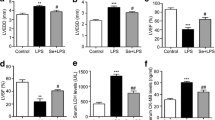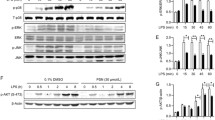Abstract—Acute lung injury (ALI) is characterized by a series of inflammatory reactions and serves as the main cause of mortality in intensive care unit patients. Although great progress has been made in understanding the pathophysiology of ALI, there are no effective treatments in clinic. Recently, we have synthesized a selenium-containing compound, which possesses obvious anti-inflammatory activity. The aim of the present study is to evaluate the protective effects of the selenium-containing compound 34# in LPS-induced ALI in mice as well as its underlying mechanism. Compound 34# was found to inhibit LPS-induced macrophage inflammatory cytokine release. These effects were observed to be produced via suppression of the MAPK/AP-1 pathway. Compound 34# was also noted to attenuate the LPS-induced lung inflammation in mice with ALI. The corresponding results suggested that compound 34# possesses remarkable protective effects on LPS-induced ALI. Furthermore, the MAPK/AP-1 pathway may prove to be the underlying mechanism. Accordingly, compound 34# may serve as a potential candidate for the prevention of ALI.





Similar content being viewed by others
Data Availability
All data generated or analyzed during this study are included in this published article.
References
Ware, L.B., and M.A. Matthay. 2000. The acute respiratory distress syndrome. New England Journal of Medicine 342 (18): 1334–1349. https://doi.org/10.1056/NEJM200005043421806.
Bellani G.; Laffey J. G.; Pham T.; Fan E.; Brochard L.; Esteban A.; Gattinoni L.; van Haren, F.; Larsson, A.; McAuley, D. F.; Ranieri, M.; Rubenfeld, G.; Thompson, B. T.; Wrigge, H.; Slutsky, A. S.; Pesenti, A.; Investigators, L. S.; Group, E. T. 2016. Epidemiology, patterns of care, and mortality for patients with acute respiratory distress syndrome in intensive care units in 50 countries. JAMA 315 (8): 788–800. https://doi.org/10.1001/jama.2016.0291.
Diaz, J.V., R. Brower, C.S. Calfee, and M.A. Matthay. 2010. Therapeutic strategies for severe acute lung injury. Critical Care Medicine 38 (8): 1644–1650. https://doi.org/10.1097/CCM.0b013e3181e795ee.
Matthay, M. A., R.L. G.A. Zemans, Y. M. Arabi, J.R. Beitler, A. Mercat, M. Herridge, A.G. Randolph, and C.S. Calfee. 2019. Acute respiratory distress syndrome. Nature Reviews Disease Primers 5 (1): 18. https://doi.org/10.1038/s41572-019-0069-0.
Zhang, Y., T. Xu, Z. Pan, X. Ge, C. Sun, C. Lu, H. Chen, Z. Xiao, B. Zhang, Y. Dai, and G. Liang. 2018. Shikonin inhibits myeloid differentiation protein 2 to prevent LPS-induced acute lung injury. British Journal of Pharmacology 175 (5): 840–854. https://doi.org/10.1111/bph.14129.
Manzanares, W., E. Moreira, and G. Hardy. 2021. Pharmaconutrition revisited for critically ill patients with coronavirus disease 2019 (COVID-19): Does selenium have a place? Nutrition 81: 110989. https://doi.org/10.1016/j.nut.2020.110989.
Xiong, Y., Q. Yin, E. Jin, H. Chen, and S. He. 2020. Selenium attenuates chronic heat stress-induced apoptosis via the inhibition of endoplasmic reticulum stress in mouse granulosa cells. Molecules 25 (3). https://doi.org/10.3390/molecules25030557.
Liu, H.J., Y. Qin, Z.H. Zhao, Y. Zhang, J.H. Yang, D.H. Zhai, F. Cui, C. Luo, M.X. Lu, P.P. Liu, H.W. Xu, K. Li, B. Sun, S. Chen, H.G. Zhou, C. Yang, and T. Sun. 2020. Lentinan-functionalized selenium nanoparticles target tumor cell mitochondria via TLR4/TRAF3/MFN1 pathway. Theranostics 10 (20): 9083–9099. https://doi.org/10.7150/thno.46467.
Mita, Y., K. Nakayama, S. Inari, Y. Nishito, Y. Yoshioka, N. Sakai, K. Sotani, T. Nagamura, Y. Kuzuhara, K. Inagaki, M. Iwasaki, H. Misu, M. Ikegawa, T. Takamura, N. Noguchi, and Y. Saito. 2017. Selenoprotein P-neutralizing antibodies improve insulin secretion and glucose sensitivity in type 2 diabetes mouse models. Nature communications 8 (1): 1658. https://doi.org/10.1038/s41467-017-01863-z.
Tang, C., S. Li, K. Zhang, J. Li, Y. Han, T. Zhan, Q. Zhao, X. Guo, and J. Zhang. 2020. Selenium deficiency-induced redox imbalance leads to metabolic reprogramming and inflammation in the liver. Redox Biology 36: 101519. https://doi.org/10.1016/j.redox.2020.101519.
Rayman, M.P. 2012. Selenium and human health. Lancet 379 (9822): 1256–1268. https://doi.org/10.1016/S0140-6736(11)61452-9.
Tindell, R., S.B. Wall, Q. Li, R. Li, K. Dunigan, R. Wood, and T.E. Tipple. 2018. Selenium supplementation of lung epithelial cells enhances nuclear factor E2-related factor 2 (Nrf2) activation following thioredoxin reductase inhibition. Redox Biology 19: 331–338. https://doi.org/10.1016/j.redox.2018.07.020.
Manikova, D., Z. Sestakova, J. Rendekova, D. Vlasakova, P. Lukacova, E. Paegle, P. Arsenyan, and M. Chovanec. 2018. Resveratrol-inspired benzo[b]selenophenes act as anti-oxidants in yeast. Molecules 23 (2). https://doi.org/10.3390/molecules23020507.
Chen, W., J. An, J. Guo, Y. Wu, L. Yang, J. Dai, K. Gong, S. Miao, S. Xi, and J. Du. 2018. Sodium selenite attenuates lung adenocarcinoma progression by repressing SOX2-mediated stemness. Cancer Chemotherapy and Pharmacology 81 (5): 885–895. https://doi.org/10.1007/s00280-018-3561-4.
Spengler, G., M. Gajdacs, M.A. Marc, E. Dominguez-Alvarez, and C. Sanmartin. 2019. Organoselenium compounds as novel adjuvants of chemotherapy drugs-a promising approach to fight cancer drug resistance. Molecules 24 (2). https://doi.org/10.3390/molecules24020336.
Hariharan, S., and S. Dharmaraj. 2020. Selenium and selenoproteins: It’s role in regulation of inflammation. Inflammopharmacology 28 (3): 667–695. https://doi.org/10.1007/s10787-020-00690-x.
Kim, E.K., and E.J. Choi. 2010. Pathological roles of MAPK signaling pathways in human diseases. Biochimica et Biophysica Acta 1802 (4): 396–405. https://doi.org/10.1016/j.bbadis.2009.12.009.
Cho, H.Y., D.L. Morgan, A.K. Bauer, and S.R. Kleeberger. 2007. Signal transduction pathways of tumor necrosis factor–mediated lung injury induced by ozone in mice. American Journal of Respiratory and Critical Care Medicine 175 (8): 829–839. https://doi.org/10.1164/rccm.200509-1527OC.
Limtrakul, P., S. Yodkeeree, P. Pitchakarn, and W. Punfa. 2016. Anti-inflammatory effects of proanthocyanidin-rich red rice extract via suppression of MAPK, AP-1 and NF-kappaB pathways in Raw 264.7 macrophages. Nutirion Reasearch and Practice 10 (3): 251–8. https://doi.org/10.4162/nrp.2016.10.3.251.
Chaiprasongsuk, A., J. Lohakul, K. Soontrapa, S. Sampattavanich, P. Akarasereenont, and U. Panich. 2017. Activation of Nrf2 reduces UVA-mediated MMP-1 upregulation via MAPK/AP-1 signaling cascades: The photoprotective effects of sulforaphane and hispidulin. Journal of Pharmacology and Experimental Therapeutics 360 (3): 388–398. https://doi.org/10.1124/jpet.116.238048.
Zhao, L., T. Zhang, H. Geng, Z.Q. Liu, Z.F. Liang, Z.Q. Zhang, J. Min, D.X. Yu, and C.Y. Zhong. 2018. MAPK/AP-1 pathway regulates benzidine-induced cell proliferation through the control of cell cycle in human normal bladder epithelial cells. Oncology Letters 16 (4): 4628–4634. https://doi.org/10.3892/ol.2018.9155.
Finkin-Groner, E., D. Moradov, H. Shifrin, C. Bejar, A. Nudelman, and M. Weinstock. 2015. Indoline-3-propionate and 3-aminopropyl carbamates reduce lung injury and pro-inflammatory cytokines induced in mice by LPS. British Journal of Pharmacology 172 (4): 1101–1113. https://doi.org/10.1111/bph.12982.
Villar, J., J. Blanco, and R.M. Kacmarek. 2016. Current incidence and outcome of the acute respiratory distress syndrome. Current Opinion in Critical Care 22 (1): 1–6. https://doi.org/10.1097/MCC.0000000000000266.
Beck-Schimmer, B., R. Schwendener, T. Pasch, L. Reyes, C. Booy, and R.C. Schimmer. 2005. Alveolar macrophages regulate neutrophil recruitment in endotoxin-induced lung injury. Respiratory Research 6: 61. https://doi.org/10.1186/1465-9921-6-61.
Wessels, I., J.T. Pupke, K.T. von Trotha, A. Gombert, A. Himmelsbach, H.J. Fischer, M.J. Jacobs, L. Rink, and J. Grommes. 2020. Zinc supplementation ameliorates lung injury by reducing neutrophil recruitment and activity. Thorax 75 (3): 253–261. https://doi.org/10.1136/thoraxjnl-2019-213357.
Kawashima, M., M. Kuwamura, M. Takeya, and J. Yamate. 2004. Morphologic characteristics of pulmonary macrophages in cetaceans: Particular reference to pulmonary intravascular macrophages as a newly identified type. Veterinary Pathology 41 (6): 682–686. https://doi.org/10.1354/vp.41-6-682.
Belperio, J.A., M.P. Keane, M.D. Burdick, V. Londhe, Y.Y. Xue, K. Li, R.J. Phillips, and R.M. Strieter. 2002. Critical role for CXCR2 and CXCR2 ligands during the pathogenesis of ventilator-induced lung injury. The Journal of Clinical Investigation 110 (11): 1703–1716. https://doi.org/10.1172/JCI15849.
Williams, A.E., and R.C. Chambers. 2014. The mercurial nature of neutrophils: Still an enigma in ARDS? American Journal of Physiology. Lung Cellular and Molecular Physiology 306 (3): L217–L230. https://doi.org/10.1152/ajplung.00311.2013.
Chalmers, J.D., C.S. Haworth, M.L. Metersky, M.R. Loebinger, F. Blasi, O. Sibila, A.E. O’Donnell, E.J. Sullivan, K.C. Mange, C. Fernandez, J. Zou, C.L. Daley, and W. Investigators. 2020. Phase 2 trial of the DPP-1 inhibitor brensocatib in bronchiectasis. New England Journal of Medicine 383 (22): 2127–2137. https://doi.org/10.1056/NEJMoa2021713.
Acknowledgements
We would like to give our sincere gratitude to the reviewers for their constructive comments.
Funding
This study was supported by the Wenzhou Scientific and Technology Program (Y2020174), National College Student Innovation and Entrepreneurship Training Program (202010343011), and Wenzhou Medical University Scientific Research Projects of College Students (wyx2020101027).
Author information
Authors and Affiliations
Contributions
Data curation, Zaisheng Zhu, Wenjing Jia; formal analysis, Wenjing Jia; funding acquisition, Wenting Ding and Zaisheng Zhu; methodology, Wenjing Jia, Yali Zhang and Xinmiao Chen; validation, Meihong Wang, Zhengwei Xu, and Yelin Tang; visualization, Bin Zheng and Xinmiao Chen; writing — original draft, Wenjing Jia; writing—review and editing, Tao Wei and Zaisheng Zhu.
Corresponding authors
Ethics declarations
Conflict of Interest
The authors declare no competing interests.
Additional information
Publisher's Note
Springer Nature remains neutral with regard to jurisdictional claims in published maps and institutional affiliations.
Supplementary Information
Below is the link to the electronic supplementary material.
Rights and permissions
About this article
Cite this article
Jia, W., Ding, W., Chen, X. et al. Selenium-Containing Compound Ameliorates Lipopolysaccharide-Induced Acute Lung Injury via Regulating the MAPK/AP-1 Pathway. Inflammation 44, 2518–2530 (2021). https://doi.org/10.1007/s10753-021-01521-z
Received:
Accepted:
Published:
Issue Date:
DOI: https://doi.org/10.1007/s10753-021-01521-z




